https://github.com/crossoverJie/JCSprout
原创: crossoverJie 阅读原文
前言
Netty 是一个高性能的 NIO 网络框架,本文基于 SpringBoot 以常见的心跳机制来认识 Netty。
最终能达到的效果:
客户端每隔 N 秒检测是否需要发送心跳。
服务端也每隔 N 秒检测是否需要发送心跳。
服务端可以主动 push 消息到客户端。
基于 SpringBoot 监控,可以查看实时连接以及各种应用信息。
效果如下:
IdleStateHandler
Netty 可以使用 IdleStateHandler 来实现连接管理,当连接空闲时间太长(没有发送、接收消息)时则会触发一个事件,我们便可在该事件中实现心跳机制。
客户端心跳
当客户端空闲了 N 秒没有给服务端发送消息时会自动发送一个心跳来维持连接。
核心代码代码如下:
public class EchoClientHandle extends SimpleChannelInboundHandler<ByteBuf> {private final static Logger LOGGER = LoggerFactory.getLogger(EchoClientHandle.class);@Overridepublic void userEventTriggered(ChannelHandlerContext ctx, Object evt) throws Exception {if (evt instanceof IdleStateEvent){IdleStateEvent idleStateEvent = (IdleStateEvent) evt ;if (idleStateEvent.state() == IdleState.WRITER_IDLE){LOGGER.info("已经 10 秒没有发送信息!");//向服务端发送消息CustomProtocol heartBeat = SpringBeanFactory.getBean("heartBeat", CustomProtocol.class);ctx.writeAndFlush(heartBeat).addListener(ChannelFutureListener.CLOSE_ON_FAILURE) ;}}super.userEventTriggered(ctx, evt);}@Overrideprotected void channelRead0(ChannelHandlerContext channelHandlerContext, ByteBuf in) throws Exception {//从服务端收到消息时被调用LOGGER.info("客户端收到消息={}",in.toString(CharsetUtil.UTF_8)) ;}}
实现非常简单,只需要在事件回调中发送一个消息即可。
由于整合了 SpringBoot ,所以发送的心跳信息是一个单例的 Bean。
@Configurationpublic class HeartBeatConfig {@Value("${channel.id}")private long id ;@Bean(value = "heartBeat")public CustomProtocol heartBeat(){return new CustomProtocol(id,"ping") ;}}
这里涉及到了自定义协议的内容,请继续查看下文。
当然少不了启动引导:
@Componentpublic class HeartbeatClient {private final static Logger LOGGER = LoggerFactory.getLogger(HeartbeatClient.class);private EventLoopGroup group = new NioEventLoopGroup();@Value("${netty.server.port}")private int nettyPort;@Value("${netty.server.host}")private String host;private SocketChannel channel;@PostConstructpublic void start() throws InterruptedException {Bootstrap bootstrap = new Bootstrap();bootstrap.group(group).channel(NioSocketChannel.class).handler(new CustomerHandleInitializer());ChannelFuture future = bootstrap.connect(host, nettyPort).sync();if (future.isSuccess()) {LOGGER.info("启动 Netty 成功");}channel = (SocketChannel) future.channel();}}public class CustomerHandleInitializer extends ChannelInitializer<Channel> {@Overrideprotected void initChannel(Channel ch) throws Exception {ch.pipeline()//10 秒没发送消息 将IdleStateHandler 添加到 ChannelPipeline 中.addLast(new IdleStateHandler(0, 10, 0)).addLast(new HeartbeatEncode()).addLast(new EchoClientHandle());}}
所以当应用启动每隔 10 秒会检测是否发送过消息,不然就会发送心跳信息。
服务端心跳
服务器端的心跳其实也是类似,也需要在 ChannelPipeline 中添加一个 IdleStateHandler 。
public class HeartBeatSimpleHandle extends SimpleChannelInboundHandler<CustomProtocol> {private final static Logger LOGGER = LoggerFactory.getLogger(HeartBeatSimpleHandle.class);private static final ByteBuf HEART_BEAT = Unpooled.unreleasableBuffer(Unpooled.copiedBuffer(new CustomProtocol(123456L,"pong").toString(),CharsetUtil.UTF_8));/*** 取消绑定* @param ctx* @throws Exception*/@Overridepublic void channelInactive(ChannelHandlerContext ctx) throws Exception {NettySocketHolder.remove((NioSocketChannel) ctx.channel());}@Overridepublic void userEventTriggered(ChannelHandlerContext ctx, Object evt) throws Exception {if (evt instanceof IdleStateEvent){IdleStateEvent idleStateEvent = (IdleStateEvent) evt ;if (idleStateEvent.state() == IdleState.READER_IDLE){LOGGER.info("已经5秒没有收到信息!");//向客户端发送消息ctx.writeAndFlush(HEART_BEAT).addListener(ChannelFutureListener.CLOSE_ON_FAILURE) ;}}super.userEventTriggered(ctx, evt);}@Overrideprotected void channelRead0(ChannelHandlerContext ctx, CustomProtocol customProtocol) throws Exception {LOGGER.info("收到customProtocol={}", customProtocol);//保存客户端与 Channel 之间的关系NettySocketHolder.put(customProtocol.getId(),(NioSocketChannel)ctx.channel()) ;}}
这里有点需要注意:
当有多个客户端连上来时,服务端需要区分开,不然响应消息就会发生混乱。
所以每当有个连接上来的时候,我们都将当前的 Channel 与连上的客户端 ID 进行关联(因此每个连上的客户端 ID 都必须唯一)。
这里采用了一个 Map 来保存这个关系,并且在断开连接时自动取消这个关联。
public class NettySocketHolder {private static final Map<Long, NioSocketChannel> MAP = new ConcurrentHashMap<>(16);public static void put(Long id, NioSocketChannel socketChannel) {MAP.put(id, socketChannel);}public static NioSocketChannel get(Long id) {return MAP.get(id);}public static Map<Long, NioSocketChannel> getMAP() {return MAP;}public static void remove(NioSocketChannel nioSocketChannel) {MAP.entrySet().stream().filter(entry -> entry.getValue() == nioSocketChannel).forEach(entry -> MAP.remove(entry.getKey()));}}
启动引导程序:
Componentpublic class HeartBeatServer {private final static Logger LOGGER = LoggerFactory.getLogger(HeartBeatServer.class);private EventLoopGroup boss = new NioEventLoopGroup();private EventLoopGroup work = new NioEventLoopGroup();@Value("${netty.server.port}")private int nettyPort;/*** 启动 Netty** @return* @throws InterruptedException*/@PostConstructpublic void start() throws InterruptedException {ServerBootstrap bootstrap = new ServerBootstrap().group(boss, work).channel(NioServerSocketChannel.class).localAddress(new InetSocketAddress(nettyPort))//保持长连接.childOption(ChannelOption.SO_KEEPALIVE, true).childHandler(new HeartbeatInitializer());ChannelFuture future = bootstrap.bind().sync();if (future.isSuccess()) {LOGGER.info("启动 Netty 成功");}}/*** 销毁*/@PreDestroypublic void destroy() {boss.shutdownGracefully().syncUninterruptibly();work.shutdownGracefully().syncUninterruptibly();LOGGER.info("关闭 Netty 成功");}}public class HeartbeatInitializer extends ChannelInitializer<Channel> {@Overrideprotected void initChannel(Channel ch) throws Exception {ch.pipeline()//五秒没有收到消息 将IdleStateHandler 添加到 ChannelPipeline 中.addLast(new IdleStateHandler(5, 0, 0)).addLast(new HeartbeatDecoder()).addLast(new HeartBeatSimpleHandle());}}
也是同样将IdleStateHandler 添加到 ChannelPipeline 中,也会有一个定时任务,每5秒校验一次是否有收到消息,否则就主动发送一次请求。
因为测试是有两个客户端连上所以有两个日志。
自定义协议
上文其实都看到了:服务端与客户端采用的是自定义的 POJO 进行通讯的。
所以需要在客户端进行编码,服务端进行解码,也都只需要各自实现一个编解码器即可。
CustomProtocol:
public class CustomProtocol implements Serializable{private static final long serialVersionUID = 4671171056588401542L;private long id ;private String content ;//省略 getter/setter}
客户端的编码器:
public class HeartbeatEncode extends MessageToByteEncoder<CustomProtocol> {@Overrideprotected void encode(ChannelHandlerContext ctx, CustomProtocol msg, ByteBuf out) throws Exception {out.writeLong(msg.getId()) ;out.writeBytes(msg.getContent().getBytes()) ;}}
也就是说消息的前八个字节为 header,剩余的全是 content。
服务端的解码器:
public class HeartbeatDecoder extends ByteToMessageDecoder {@Overrideprotected void decode(ChannelHandlerContext ctx, ByteBuf in, List<Object> out) throws Exception {long id = in.readLong() ;byte[] bytes = new byte[in.readableBytes()] ;in.readBytes(bytes) ;String content = new String(bytes) ;CustomProtocol customProtocol = new CustomProtocol() ;customProtocol.setId(id);customProtocol.setContent(content) ;out.add(customProtocol) ;}}
只需要按照刚才的规则进行解码即可。
实现原理
其实联想到 IdleStateHandler 的功能,自然也能想到它实现的原理:
应该会存在一个定时任务的线程去处理这些消息。
来看看它的源码:
首先是构造函数:
public IdleStateHandler(int readerIdleTimeSeconds,int writerIdleTimeSeconds,int allIdleTimeSeconds) {this(readerIdleTimeSeconds, writerIdleTimeSeconds, allIdleTimeSeconds,TimeUnit.SECONDS);}
其实就是初始化了几个数据:
readerIdleTimeSeconds:一段时间内没有数据读取
writerIdleTimeSeconds:一段时间内没有数据发送
allIdleTimeSeconds:以上两种满足其中一个即可
因为 IdleStateHandler 也是一种 ChannelHandler,所以会在 channelActive 中初始化任务:
@Overridepublic void channelActive(ChannelHandlerContext ctx) throws Exception {// This method will be invoked only if this handler was added// before channelActive() event is fired. If a user adds this handler// after the channelActive() event, initialize() will be called by beforeAdd().initialize(ctx);super.channelActive(ctx);}private void initialize(ChannelHandlerContext ctx) {// Avoid the case where destroy() is called before scheduling timeouts.// See: https://github.com/netty/netty/issues/143switch (state) {case 1:case 2:return;}state = 1;initOutputChanged(ctx);lastReadTime = lastWriteTime = ticksInNanos();if (readerIdleTimeNanos > 0) {readerIdleTimeout = schedule(ctx, new ReaderIdleTimeoutTask(ctx),readerIdleTimeNanos, TimeUnit.NANOSECONDS);}if (writerIdleTimeNanos > 0) {writerIdleTimeout = schedule(ctx, new WriterIdleTimeoutTask(ctx),writerIdleTimeNanos, TimeUnit.NANOSECONDS);}if (allIdleTimeNanos > 0) {allIdleTimeout = schedule(ctx, new AllIdleTimeoutTask(ctx),allIdleTimeNanos, TimeUnit.NANOSECONDS);}}
也就是会按照我们给定的时间初始化出定时任务。
接着在任务真正执行时进行判断:
private final class ReaderIdleTimeoutTask extends AbstractIdleTask {ReaderIdleTimeoutTask(ChannelHandlerContext ctx) {super(ctx);}@Overrideprotected void run(ChannelHandlerContext ctx) {long nextDelay = readerIdleTimeNanos;if (!reading) {nextDelay -= ticksInNanos() - lastReadTime;}if (nextDelay <= 0) {// Reader is idle - set a new timeout and notify the callback.readerIdleTimeout = schedule(ctx, this, readerIdleTimeNanos, TimeUnit.NANOSECONDS);boolean first = firstReaderIdleEvent;firstReaderIdleEvent = false;try {IdleStateEvent event = newIdleStateEvent(IdleState.READER_IDLE, first);channelIdle(ctx, event);} catch (Throwable t) {ctx.fireExceptionCaught(t);}} else {// Read occurred before the timeout - set a new timeout with shorter delay.readerIdleTimeout = schedule(ctx, this, nextDelay, TimeUnit.NANOSECONDS);}}}
如果满足条件则会生成一个 IdleStateEvent 事件。
SpringBoot 监控
由于整合了 SpringBoot 之后不但可以利用 Spring 帮我们管理对象,也可以利用它来做应用监控。
actuator 监控
当我们为引入了:
<dependency><groupId>org.springframework.boot</groupId><artifactId>spring-boot-starter-actuator</artifactId></dependency>
就开启了 SpringBoot 的 actuator 监控功能,他可以暴露出很多监控端点供我们使用。
如一些应用中的一些统计数据:
存在的 Beans: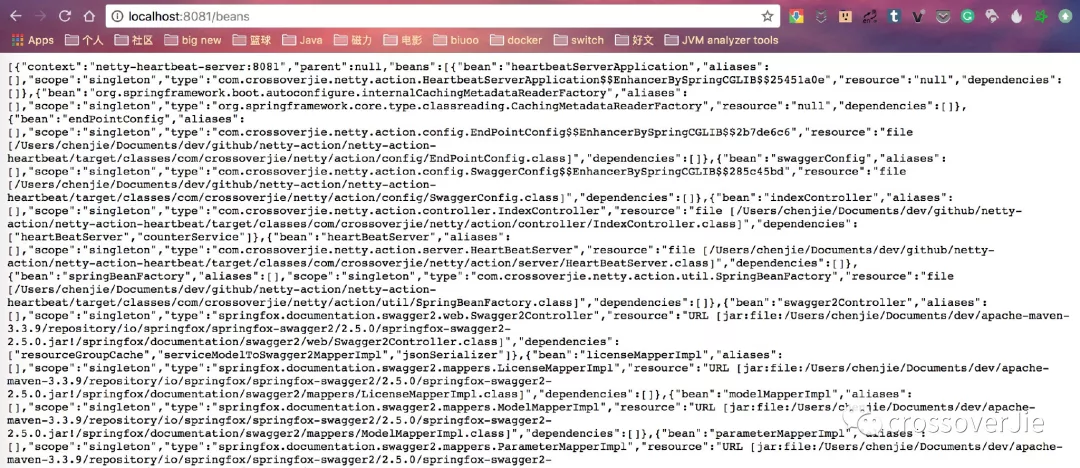
更多信息请查看:https://docs.spring.io/spring-boot/docs/current/reference/html/production-ready-endpoints.html
但是如果我想监控现在我的服务端有多少客户端连上来了,分别的 ID 是多少?
其实就是实时查看我内部定义的那个关联关系的 Map。
这就需要暴露自定义端点了。
自定义端点
暴露的方式也很简单:
继承 AbstractEndpoint 并复写其中的 invoke 函数:
public class CustomEndpoint extends AbstractEndpoint<Map<Long,NioSocketChannel>> {/*** 监控端点的 访问地址* @param id*/public CustomEndpoint(String id) {//false 表示不是敏感端点super(id, false);}@Overridepublic Map<Long, NioSocketChannel> invoke() {return NettySocketHolder.getMAP();}}
其实就是返回了 Map 中的数据。
再配置一个该类型的 Bean 即可:
@Configurationpublic class EndPointConfig {@Value("${monitor.channel.map.key}")private String channelMap;@Beanpublic CustomEndpoint buildEndPoint(){CustomEndpoint customEndpoint = new CustomEndpoint(channelMap) ;return customEndpoint ;}}
这样我们就可以通过配置文件中的 monitor.channel.map.key 来访问了:
一个客户端连接时:
两个客户端连接时:
整合 SBA
这样其实监控功能已经可以满足了,但能不能展示的更美观、并且多个应用也可以方便查看呢?
有这样的开源工具帮我们做到了:
https://github.com/codecentric/spring-boot-admin
简单来说我们可以利用该工具将 actuator 暴露出来的接口可视化并聚合的展示在页面中:
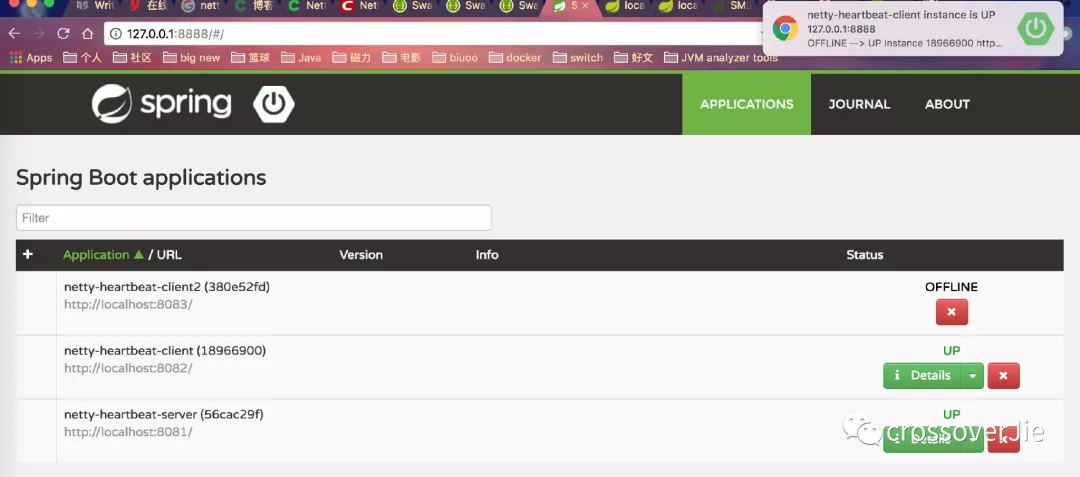
接入也很简单,首先需要引入依赖:
<dependency><groupId>de.codecentric</groupId><artifactId>spring-boot-admin-starter-client</artifactId></dependency>
并在配置文件中加入:
# 关闭健康检查权限management.security.enabled=false# SpringAdmin 地址spring.boot.admin.url=http://127.0.0.1:8888
在启动应用之前先讲 SpringBootAdmin 部署好:
这个应用就是一个纯粹的 SpringBoot ,只需要在主函数上加入 @EnableAdminServer 注解。
@SpringBootApplication@Configuration@EnableAutoConfiguration@EnableAdminServerpublic class AdminApplication {public static void main(String[] args) {SpringApplication.run(AdminApplication.class, args);}}
引入:
<dependency><groupId>de.codecentric</groupId><artifactId>spring-boot-admin-starter-server</artifactId><version>1.5.7</version></dependency><dependency><groupId>de.codecentric</groupId><artifactId>spring-boot-admin-server-ui</artifactId><version>1.5.6</version></dependency>
之后直接启动就行了。
这样我们在 SpringBootAdmin 的页面中就可以查看很多应用信息了。
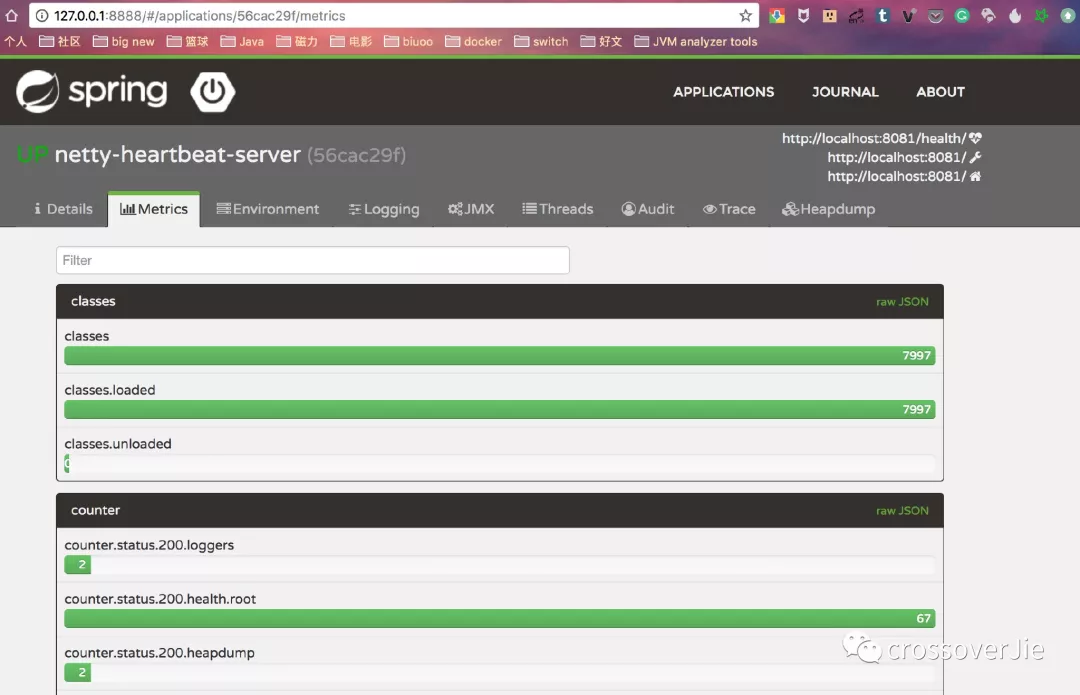
更多内容请参考官方指南:
http://codecentric.github.io/spring-boot-admin/1.5.6/
自定义监控数据
其实我们完全可以借助 actuator 以及这个可视化页面帮我们监控一些简单的度量信息。
比如我在客户端和服务端中写了两个 Rest 接口用于向对方发送消息。
只是想要记录分别发送了多少次:
客户端:
@Controller@RequestMapping("/")public class IndexController {/*** 统计 service*/@Autowiredprivate CounterService counterService;@Autowiredprivate HeartbeatClient heartbeatClient ;/*** 向服务端发消息* @param sendMsgReqVO* @return*/@ApiOperation("客户端发送消息")@RequestMapping("sendMsg")@ResponseBodypublic BaseResponse<SendMsgResVO> sendMsg(@RequestBody SendMsgReqVO sendMsgReqVO){BaseResponse<SendMsgResVO> res = new BaseResponse();heartbeatClient.sendMsg(new CustomProtocol(sendMsgReqVO.getId(),sendMsgReqVO.getMsg())) ;// 利用 actuator 来自增counterService.increment(Constants.COUNTER_CLIENT_PUSH_COUNT);SendMsgResVO sendMsgResVO = new SendMsgResVO() ;sendMsgResVO.setMsg("OK") ;res.setCode(StatusEnum.SUCCESS.getCode()) ;res.setMessage(StatusEnum.SUCCESS.getMessage()) ;res.setDataBody(sendMsgResVO) ;return res ;}}
只要我们引入了 actuator 的包,那就可以直接注入 counterService ,利用它来帮我们记录数据。
当我们调用该接口时:


在监控页面中可以查询刚才的调用情况:
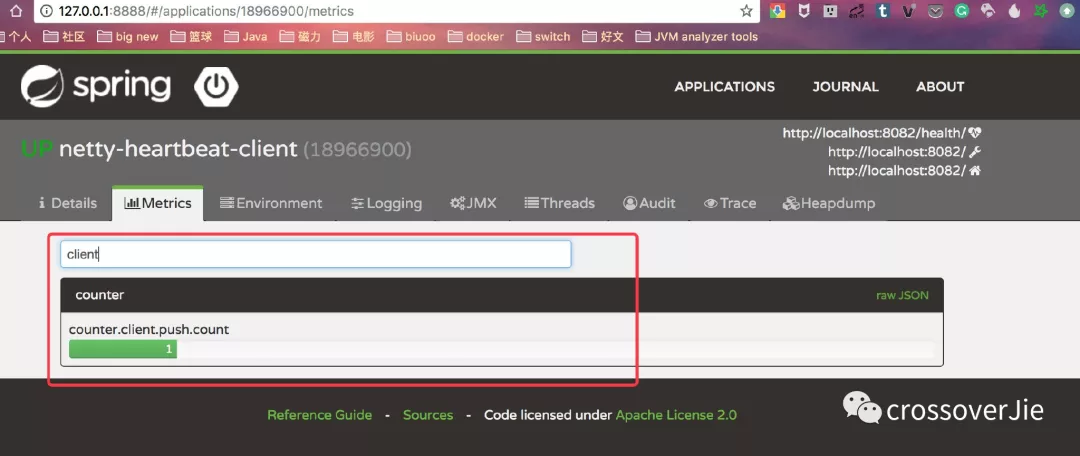
服务端主动 push 消息也是类似,只是需要在发送时候根据客户端的 ID 查询到具体的 Channel 发送:


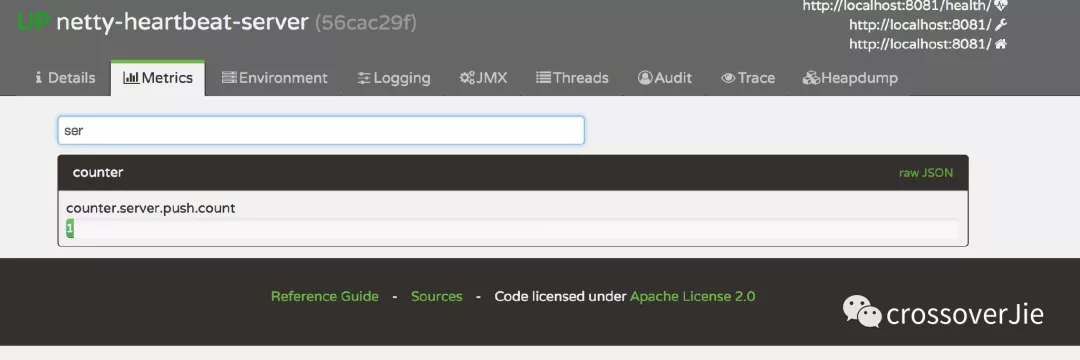
总结
以上就是一个简单 Netty 心跳示例,并演示了 SpringBoot 的监控,之后会继续更新 Netty 相关内容,欢迎关注及指正。
本文所有代码:
https://github.com/crossoverJie/netty-action
号外
最近在总结一些 Java 相关的知识点,感兴趣的朋友可以一起维护。













